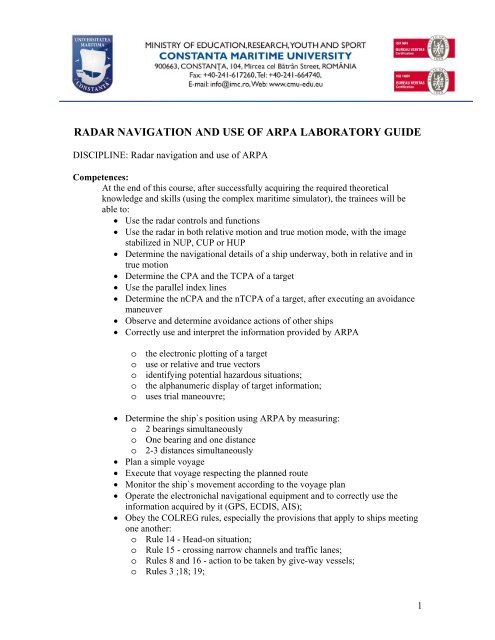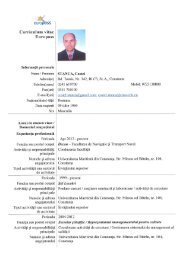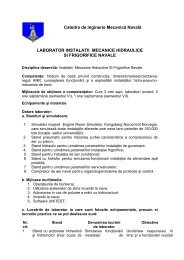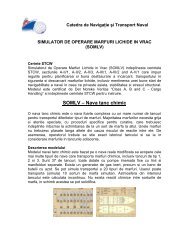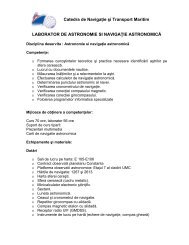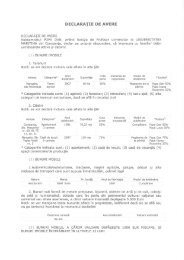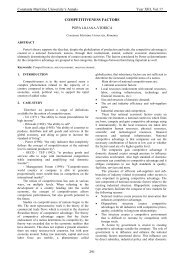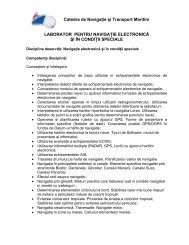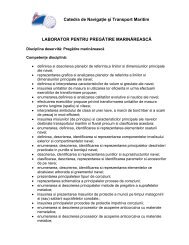RADAR NAVIGATION AND USE OF ARPA LABORATORY GUIDE
RADAR NAVIGATION AND USE OF ARPA LABORATORY GUIDE
RADAR NAVIGATION AND USE OF ARPA LABORATORY GUIDE
You also want an ePaper? Increase the reach of your titles
YUMPU automatically turns print PDFs into web optimized ePapers that Google loves.
<strong>RADAR</strong> <strong>NAVIGATION</strong> <strong>AND</strong> <strong>USE</strong> <strong>OF</strong> <strong>ARPA</strong> <strong>LABORATORY</strong> <strong>GUIDE</strong><br />
DISCIPLINE: Radar navigation and use of <strong>ARPA</strong><br />
Competences:<br />
At the end of this course, after successfully acquiring the required theoretical<br />
knowledge and skills (using the complex maritime simulator), the trainees will be<br />
able to:<br />
Use the radar controls and functions<br />
Use the radar in both relative motion and true motion mode, with the image<br />
stabilized in NUP, CUP or HUP<br />
Determine the navigational details of a ship underway, both in relative and in<br />
true motion<br />
Determine the CPA and the TCPA of a target<br />
Use the parallel index lines<br />
Determine the nCPA and the nTCPA of a target, after executing an avoidance<br />
maneuver<br />
Observe and determine avoidance actions of other ships<br />
Correctly use and interpret the information provided by <strong>ARPA</strong><br />
o the electronic plotting of a target<br />
o use or relative and true vectors<br />
o identifying potential hazardous situations;<br />
o the alphanumeric display of target information;<br />
o uses trial maneouvre;<br />
Determine the ship`s position using <strong>ARPA</strong> by measuring:<br />
o 2 bearings simultaneously<br />
o One bearing and one distance<br />
o 2-3 distances simultaneously<br />
Plan a simple voyage<br />
Execute that voyage respecting the planned route<br />
Monitor the ship`s movement according to the voyage plan<br />
Operate the electronichal navigational equipment and to correctly use the<br />
information acquired by it (GPS, ECDIS, AIS);<br />
Obey the COLREG rules, especially the provisions that apply to ships meeting<br />
one another:<br />
o Rule 14 - Head-on situation;<br />
o Rule 15 - crossing narrow channels and traffic lanes;<br />
o Rules 8 and 16 - action to be taken by give-way vessels;<br />
o Rules 3 ;18; 19;<br />
1
Navigate and make the avoidance actions required regardless of the visibility<br />
conditions or the geographical situation:<br />
o Straits, canals<br />
o Traffic separation schemes<br />
Take over and give over the navigational watch<br />
Call the Master when the situation demands it<br />
Use the ship`s sound and light systems<br />
Communicate using Standard Communication Phrases between ship to ship,<br />
and sip to shore<br />
Means to attain these competences:<br />
Lecture hours 56 , simulation/seminar hours 56 ore;<br />
Printed course handbook;<br />
Books for Radar Ploting;<br />
Course handbook in electronic layout, worldwide available;<br />
Multimedia presentations<br />
Facilities and Equipments:<br />
Instruments needed for working on the paper chart;<br />
Alidad;<br />
Gyro reapeater;<br />
Navigation charts;<br />
Pilot handbooks;<br />
Navigation lights and radio signals handbook;<br />
Radar complex simulator;<br />
<strong>ARPA</strong> Kevin Hughes Radar;<br />
The Virtual Campus internet site;<br />
The navigation simulator complex;<br />
Admiralty Charts;<br />
Admiralty List of Radio Signals;<br />
Lumeni BenQ, DLP, 1800 ANSI Video projector with and 800x600 resolution;<br />
The list of seminar/simulation laboratories for Radar navigation and use of <strong>ARPA</strong>:<br />
2
• Introduction to the radar simulator and to the Kelvin Hughes-Nucleus 6000 A radar;<br />
• The use of radar stabilized in N’UP, H’UP, C’UP (simulator Full Mission);<br />
• Radar simulation (simulator Full Mission);<br />
• Radar simulation (simulator Full Mission);<br />
• Radar simulation (simulator Full Mission);<br />
• Radar simulation, avoidance actions (using the plotting sheet);<br />
• Radar simulation, avoidance actions (using the plotting sheet);<br />
• Avoidance actions using radar observations (radar simulation);<br />
• Radar simulation, avoidance actions, (plotting sheet);<br />
• Avoiding a target ship, when the avoiding action is limited by and fixed object in<br />
the vicinity (on the plotting sheet);<br />
• Avoidance actions using radar observations (radar simulation);<br />
• Determining the best avoiding (on the plotting sheet);<br />
• Avoiding action based on the radar observations (radar simulation);<br />
• The use of parallel index lines (radar simulation);<br />
• The use of NAVLINE (radar simulation);<br />
• Radar navigation, avoiding actions, ship maneuvering – use of conventional radar<br />
techniques (Full Mission simulator);<br />
• Radar navigation, avoiding actions, ship maneuvering – use of conventional radar<br />
techniques (Full Mission simulator);<br />
• Radar navigation, avoiding actions, ship maneuvering – use of conventional radar<br />
techniques (Full Mission simulator);<br />
• Radar navigation, avoiding actions, ship maneuvering – use of conventional radar<br />
techniques (Full Mission simulator);<br />
• Electronical plotting of a target and the automatic tracking of a target –<strong>ARPA</strong> radars<br />
only (Full Mission simulator);<br />
• The TRIAL function –<strong>ARPA</strong> radar only (Full Mission simulator)<br />
• The interpretation of <strong>ARPA</strong> information (Full Mission simulator);<br />
• Self tests, errors and limitations of <strong>ARPA</strong> processors (Full Mission simulator);<br />
• The correct usage of <strong>ARPA</strong> information (Full Mission simulator);<br />
• The use of modern radar functions. Relative motion (radar simulation);<br />
• The EBL, and the safety distances. (radar simulation) ;<br />
• Radar navigation, avoidance actions, and ship maneuvering - <strong>ARPA</strong> radar (Full<br />
Mission simulator) ;<br />
• Radar navigation, avoidance actions, and ship maneuvering - <strong>ARPA</strong> radar (Full<br />
Mission simulator) ;<br />
• Radar navigation, avoidance actions, and ship maneuvering - <strong>ARPA</strong> radar (Full<br />
Mission simulator) ;<br />
• The usage of radar electronic charts, in real mode (Full Mission simulator);<br />
• Maneuvering the ship using radar electronic charts (Full Mission simulator);<br />
• Comparison between True Motion and Reletive Motion (Full Mission simulator);<br />
• Steering and maneuvering the ship, using different forms of radar motions and<br />
image stabilization– <strong>ARPA</strong> - (simulator Full Mission);<br />
• Radar image stabilization for when considering land, and/or shore. (radar<br />
simulation);<br />
• Ship traffic services, monitoring traffic from on shore radar facilities (Full Mission<br />
simulator).<br />
3


